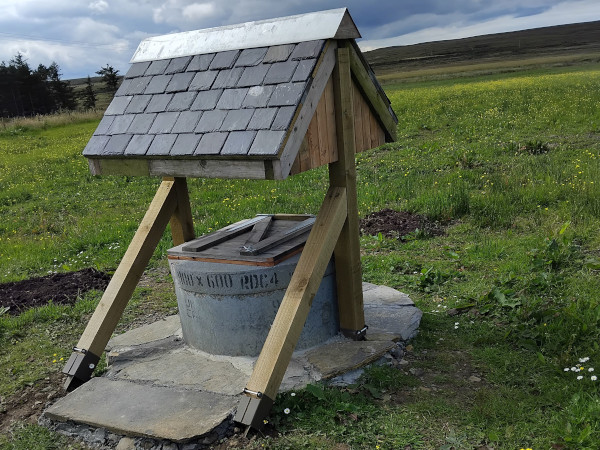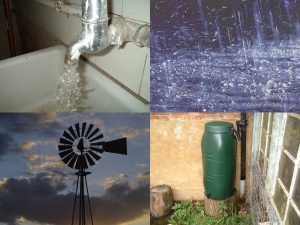Gabriel Cochrane: “I am grateful for your water”.
Queenie Turril: “Oh it ain’t my water to give sir. Water is free on God’s earth as long as the rain falls. Always will be”.
[Extract from ‘Lark Rise to Candleford’, a television adaptation of Flora Thompson’s trilogy of novels. Set in the 1800s at the onset of the industrial revolution, a traveller Gabriel Cochrane has just drawn water from the village well; Queenie, a village resident, does not predict the future.]
Prior to industrialisation, all villages will have once had at least one well, before commercialisation of the water supply. In many villages, wells were communal, with residents perhaps sharing the costs of having it built, and then manually looking after its upkeep.
Five years ago my wife and I bought a ruinous cottage on seven acres of land in Scotland, Mains water was nearby, but we baulked at getting connected: the cost was ca. £2000 for the privilege of being locked in to paying bills. Moreover, we were concerned about contaminants in mains water: pharmaceuticals, chlorine, and the potential for fluoride addition. We also wanted security should some catastrophe affect the supply infrastructure.

There was no evidence of a well however – only a field of long grass. The field was poorly drained, areas were waterlogged in winter, and rushes were prevalent.
Then, a neighbour came and told us that there was once a well on our field. She remembered drinking from it as a child, and that it supplied the best water in the village.
So, we decided to find it and try to re-open it. But, when searching for help it became apparent that the craft of well sinking is lost in the UK. There are people who will drill boreholes, but charge over £10,000 to do so. How we succeeded in building a well without paying these costs is the subject of this article.
Rainfall percolates underground where it resides in porous rock such as sandstone, trapped between impervious strata such as clay. This is called an aquifer. A well shaft can be dug down until it breaks into this aquifer, and the water drawn upwards with a bucket or a pump. Alternatively, water can flow upwards and out of the ground of its own accord, often under pressure, due to some geological feature such as a fault, and this is known as a spring.

To locate the well, we tried dowsing with hazel twigs, unsuccessfully. Matters improved when the neighbour’s husband brought some local knowledge and an old map showing the well’s former location. Using the map’s scale an approximate position could be determined, but this meant digging random holes in the hope that we made a lucky strike. Seemingly, the well was de-commissioned in the 1960s. Its shaft was filled and the water source drained into the ditch at the field boundary. Finding the drain outlet wasn’t easy as both ditch and outlet pipe were heavily blocked with mud. This explained why the field was waterlogged.
Once we found the drain outlet, all we had to do was dig a channel in-between the approximate location of the old well and the drain outlet, so cutting across the drainage channel. It was a good moment when we found, one foot below the surface, granite hardcore surrounding a perforated pipe. We then traced this drainage channel up-hill to find old stone steps covered by soil – the site of the former well.

Armed only with a recollection that Fred Dibnah once said brick well shafts were built from the top downwards, we set about researching well construction. Only three resources were found that gave any practical instruction, and these are listed at the end of this article.
In places without commercial water supply, wells can be sunk by casting concrete rings, and then undercutting the ground beneath in small increments so that the concrete ring gradually sinks downwards until it meets the aquifer. Once the top of the primary concrete ring approaches ground level another ring is placed on top, etc., and the undercutting continues until the aquifer is reached. Concrete rings are heavy so there must be some sort of lifting device, either a frame with block and tackle or a machine to put the ring(s) in position and lower them. The well digger must work inside the concrete rings, often using ladders, meaning that the internal diameter is limited to that of a person plus shovel, i.e. at least 900mm. Such a minimum diameter is also necessary for future cleaning out of the well.
For collecting water from springs, one has to isolate the flow and then perhaps channel it to a clean area. This involves excavating out to expose where the spring exits bedrock.

Driving by motorway construction one day, the idea came to buy some of those connectable concrete rings used for manholes and large rainwater drainage. We bought three, each 900mm internal diameter, along with a concrete cap that has a hole in for an iron manhole cover. They were not expensive, and delivery was cheap. One can buy other accessories, such as rubber seals and lifting rings, but we didn’t.
With the aid of a local ground-worker and his digger, we excavated out the old well shaft, and found that water was coming out of the bedrock about 1 metre below the surface. We had a spring. Therefore the sinking of concrete rings was not required, but we had to contain the water, so deviating from the instructions in books, we used concrete rings anyway.
As with all spring catchments, the water had to be diverted while the catchment is built, this meant as the first ring was lowered into position and sealed onto bedrock. Here was the tricky bit. It is obviously important to make sure that the first ring is level otherwise when subsequent rings are placed on top the sides won’t be vertical.
A local farmer assisted with his tractor to lower the first ring into position, while we used a pump to clean the area of water. Our first attempt at sealing the ring in place using postcrete didn’t work – the cement was continuously washed out from the aggregate. So we tried the old fashioned way by compacting clay around the base of the ring, and this was successful. The clay was found on-site while excavating out the spring. Subsequent rings were also sealed using clay pressed between the joints and packed around the outside.
Once contained, spring water soon filled the new well and reached equilibrium about 0.5m from the surface of the top-most concrete ring. Seasonally the water level rises and falls as water pressure changes below ground. So it is a good idea to have an overflow pipe at the top of the well, which we created and routed into the – now unblocked – field drain.
With the well shaft complete, it is equally important to have a constructed well-head to stop detritus falling in and contaminating the water. This includes a concrete or stone apron covering the ground around the well, and a place for storing the bucket for drawing water that is clean and off the ground.
We decided to build a ‘traditional’ well head using timber frame with a slate roof, and local flagstone for the apron. Our galvanised bucket is kept on a hook under the roof of the well head. Diagonal bracing was added for resisting very strong local winds.
The water from our well is fresh and invigorating to drink. It does not have the chemical taste of mains tap water nor its ‘flatness’. Also, we are fortunate that we live in a region of high ground, and the surrounding soil has not been subject to modern farming (chemical treatment) for many decades.
Resources
Watt, S.B., Wood, W.E. 1977, Hand dug wells and their construction, ITDG Publishing, Rugby.
Collins, S. 2000, Hand Dug Shallow Wells, chapter 5 – Principles of hand-dug wells, Manuals on drinking water supply, volume 5. Skat, St. Gallen.
Meuli, C., Wehrle, K. 2001. Spring Catchment, chapter 5 – Design and construction of a spring catchment, Manuals on drinking water supply, volume 4. Skat, St. Gallen.





